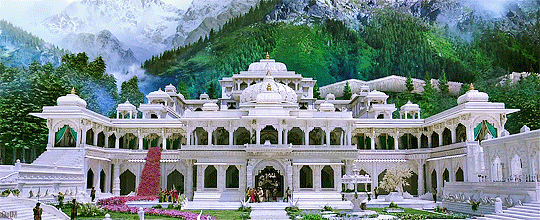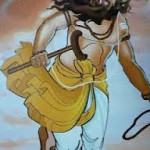Following our previous articles on Governance and the Royal Regimen is one that is more leisure in nature. It encompasses both the inspiring and pleasing of the aspects of Governance yet can directly impact the functioning of a state.
The next article in our Continuing Series on Rajadharma, is the Royal Household.
Introduction
There are some who may outright reject any discussion of monarchy. Indeed, there are a panoply of reasons to sympathise with their allergy; however, whatever the record of indic monarchy, it is important to take note of the fact that its pros and cons continue to be discussed to this day, given the numerous constitutional monarchies around the world.
Unlike a dictator, who has no rules and can do anything to preserve power, a king (especially a dharmic king) has rules that he too must follow. The Raaja maybe sovereign in the realm, but it is Dharma that is supreme. This Dharma is not mere obedience to elders or spiritual power, but the saadhaarana dharma which upholds Rta, the cosmic order. The transactional truth saamaanya sathyam can be broken for the Ultimate truth, Sathyasya Sathyam or Sathyam Param. Performance of karmakanda is Rta, but superior to even Rta is Sathyasya Sathyam, which is Sathya-Prema. Truth-Love is neither robotic truth nor brainless love, but the fusion of truth and love, which gives insight into the Ultimate Reality while at the same time observing the spirit of love that desires the well-being of all beings. If another being must be slain, it is only for the preservation of Sathya-Prema, rather than personal whims or unthinking obedience.
Political order, krama, is preserved not simply to impose one’s rule, but by weaving harmony and coexistence of all beings. To that end, Rta (the moral order) is upheld. But even this too can be disregarded when those who perform Rta have fallen into egomania. When that is the case, for the sake of Sathyasya Sathyam (the truth of truth) which is Sathya-Prema, then Rta too can be broken. In this state of Nirrta (chaos), Anrtam (immoral order) is avoided. When violators have been punished, then Rta can be restored.
Therefore, the Raaja must rule over his Household as he rules over his Raajya—with Sathya-Prema. This is the origin of Harmony, which is upheld by Justice. All, including the Raaja and his Vamsa, are subject to Dharma. When this is the case, his subordinates take note and act accordingly, not only in the Houses of Government, but in the Home of the Ruler. That is the importance of proper governance of the Royal Household.
Terminology
- Garha—Household
- Grhasambhaashana—Domestic
- Pasthyaa—Estate
- Sthaavara—Estate/Real Estate
- Vamsabhojya—Dynastic Estate
- Protocol—Upachaara/Smaranalikhitha
- Aupachaarika—Formality
- Anaupachaarika—Informality
- Anumathih—Permission
- Bhavana— Royal Palace
- Vilaasa—Dynastic Palace
- Praasaadha—Atelier/Pleasure Palace
- Vamsa Nivaasa—Dynastic Residence
- Manusyaalaya—Manor
- Aaraama—Guest House
- Utaja—Cottage
- Kutaja—Hut
- Aalindah—Verandah
- Thamangana—Balcony
- Tharangana—Observation Tower
- Gopura—Tower
- Parnashaala—Gardenhouse
- Patamandapa—Gazebo
- Gala—Dome
- Kaksha—Room
- Jaalaakshah—Lattice/Jaali
- Gavaakshah/ Vaathaayanam—Window
- Dvaara—Door
- Sammaarjanam—Floor
- Saaranee/Sammardhanam—Table
- Aasandhi—Chair
- Udhyaana—Garden
- Vaatika —Orchard
- Jalaakara—Fountain
- Manikarni—Sacred Pool
- Pushkarini/Suparna—Lotus Pond
- Saarasa—Pond
- Kulya—Canal
- Vaapi/Koopa—Well
- Vinodhasthaana—Recreational/Pleasure Ground
- Kreedaanga—Playground
- Kunchikaam—Keys
- Thaalaka—Lock
Household Staff—Garha Parichaarya
- Dauvaaraka/Dauvaarikaa—Royal Chamberlain
- Paalaagala—Royal Courier
- Vegin—Runner/Footman/Courier
- Soodha—Cook
- Anusoodha—Assistant Cook
- Aaraalaka/Aaraalikaa—Maitr d’
- Parivesaka/Parivesikaa—Waiter/Waitress
- Raaja-Rasaadha—King’s Taster
- Soochaka/Soochikaa—Tailor/Seamstress
- Shreekarana—Secretary
- Prasathaka—Personal Aide
- Prasaadhaka—Valet de Chambre
- Vaitaanika/Kinkarah—Attendant
- Karmaree—Maid
- Sahaayaka—Helper/Bellhop
- Sauchaka—Janitor
- Bhrthya/Bhrtthi— Servant
- Daasa/Daasi—Indentured Servant
- Kusheelava—Minstrel/Bard
- Dvaarapaala/Prathihaara—Doorkeeper/Gatekeeper
- Vetrin/Vetradhaara—Staff bearer
- Khadgaadhara—Sword bearer
- Dandapaani—Rod Bearer
- Lagnaka—Security
- Rakshaka—Protector
- Rakshin—Guard
- Paryatthan—Patrol
- Parichaaraka/Parichaara—Patrolman
- Prahaaraka—Sentry
- Prajaagara/Garvaatha—Watchman
Manorial Management—Manusyaalaya Manotrthva
- Antharvamsaka/Antharvamsikaa—Steward/Palace Commandant
- Manotr—Manager
- Sabhadhikaari—Royal Court Official
- Parichaarya—Staff
- Dhauhadhaka/Dhauhadhikaa—Groundskeeper/Landscaper
- Vyaadha—Gamekeeper
- Udhyaanapaala—Royal Gardener
- Vaatapaala—Orchardkeeper
- Pushpajeeva/ Shandapala —Florist
- Nalakaara—Plumber
- Thaalakakaara—Locksmith
- Goshtha Mukhya/Ashvavaaha—Chief of Stables/ Stable Warden
- Shunapaala—Master of Hounds
- Syenapaala—Falconer
- Ashvapaala—Master of Horse
- Rathapaala—Master of Chariots
- Gajapaala—Master of Elephants
- Hasthipaka—Mahout
- Padhapasaka/Padhapasikaa—Tetherers
- Vanapaala—Forest Warden/Ranger
- Vanachaaraka/Vanacharikaa— Trackers
- Ankastha—Trainer
- Jangulividha—Antiveninist
- Ashvaroha—Cavalier
- Adhorana—Squire
- Arohaka—Expert rider
- Yavashaka/Aupacharikaa—Feeder/Groomer
- Sthana—Stall
Royal Household

Operation of a Royal Household or CountryEstate is an essential aspect of Royalty, upper Aristocracy, and even lesser Aristocracy (i.e. Gentry). State dinners, religious functions, cultural festivals, all these are upheld and managed by the Royal household. A detailed division-of-labour and well-managed organisation are key to ensuring these events go off without a hitch.
Even the day-to-day management of the Royal Palace requires special attention—and can often be a matter of life-and-death. Therefore, the wise Raaja will appoint trusted and competent officials and staff, who have character. The two most important of these positions, therefore, are the Dauvaaraka (Royal Chamberlain) and Antharvamsaka (Steward/Palace Commandant). One is the Chief-of-Staff and runs the Royal Household, the other is the Manorial Chief, and secures the grounds, ensures supplies, and oversees entry-and-exit. These are not service positions, but are leadership positions in their own right. They are best staffed by either an highly trusted family member or a loyal career bureaucrat (kaayastha) who has been in service for a long-time.
Excellences of a Country Estate
A country estate is one of the blessings of elite and royal life that lightens the heavy burdens of responsibility and governance. Palace life must be well-organised, but can often be stultifying, necessitating holidays at dynastic residences at beautiful locales. As palace management cannot always accompany members of the royal or aristocratic family, estate management applies even to country estates and lesser dynastic residences.
Long days on the hunt often result in culinary fanfare at the evening royal table. Rajput shoola (spear) grilling was a celebrated and enjoyable endeavour for the ruling class of Rajasthan and other parts of Northern India. Hunting is a royal pastime practiced to this day—though it should be practiced in moderation to retain the population of species. Ethics is also necessary, and those who know the life of Minhas Rajput Banda Bahadur know to avoid targeting female animals when possible. In addition, wild boar was a dangerous animal that required great courage (and risk) to bring to the dinner table—only the skilled should be permitted to hunt it.
Household Management Structure
Raaja (The King)
Dauvaaraka (Chamberlain) Antharvamsaka (Steward)
“The duties of the Dauvarika (literally ‘doorkeeper’), were those of a Cham-berlain—arranging the King’s programme, looking after his comforts, ensuring that the King’s valet and barber were issued clothes and im-plements in sealed packages etc. The Antarvamsika (Palace Commandant) was an important official controlling the king’s appointments. We find a mention antarvamsikasainya (the King’s Own Guards) as guarding the king, not only in the palace {1.20.13 and 1.21.3} but also in the camp when on a military expedition {10.1.3}” [5, 209]
A wise king will appoint trusted dynastic retainers to the positions of Chamberlain and Steward. These should typically be of different samudhaayas (so as to reduce conspiracy) and are ideally a Kaayastha and Ayudheeya rank Kshatriya respectively, rather than one of Royal (Raajanya) rank.
A wise king will also pay the chief bodyguard (Raaja Rakshin Mukhya) and chief of the Palace Security (Vilaasa Lagnaka) directly out of his own purse. The Chamberlain and Steward may be paid out of the Royal Treasury, or again out of the King’s purse, separately from the mukhyas. The Mantri Parishad must be paid directly out of the Royal Treasury.
The Raaja Rakshin mukhya reports directly to and is remunerated directly by the Raaja. However, in the absence of the Raaja, the Dauvaaraka may give instructions in his stead.
Dauvaaraka (Chamberlain)
Dauvaaraka (Chamberlain/Chief of Staff)
Guard, Cook, Valet, Maitr D’ , Courier, Maid
The Royal Chamberlain is called the Dauvaaraka. Those of lesser houses are called Dvaarapaala. He is the Chief-of-Staff. He runs the Royal Household and House Staff. He manages the Household Budget.
The Dvaarapaala does not oversee the Antharvamsaka, but is senior to him, and may give instructions to him in the King’s absence. The Head of King’s Guard, Royal Chef, Maitr D’, Lead Maid, Footmen, etc, all report to the Dauvaaraka. He is the in-charge for Palace events and Guest Management. Exterior arrangements he will coordinate with the Antharvamsaka.
The Raaja Rakshin—King’s Own Guard serve as the personal security. The Raaja Prasaadhaka is the Royal Valet, and is in charge of the King’s Wardrobe and Tent, whilst on expedition. The Shreekarana or King’s Secretary, is in charge of his papers and appointments, and takes dictation. Formal documents are passed on to the Mahalipika or Royal Scribe. The Raaja Rakshin Mukhya reports to the Dauvaaraka. This personal bodyguard may be posted inside the house or may accompany the King and family during travel. As empires grow, a larger subordinate body called Vamsa Rakshin can serve the dynasty, and outer palace grounds under the Antharvamsaka
Antharvamsaka (Steward/Palace Commandant/Manor Manager)
Antharvamsaka (Steward/Palace Commandant)
Gardener, Groundskeeper, Gamekeeper, Masters of Horse & Hound, Palace Security
The Steward, Palace Commandant & Logistics Manager is called the Antharvamsikaa or Antharvamsaka. Those of lesser houses are called Manotr. He is the Head of Palace Operations and the Chief of Grounds Staff. The Groundskeeper, Gamekeeper, Master of Hound & Horse, Gardener, and Palace Guard all report to him. He is also the chief of logistics, making sure basic supplies are received, entry and exit security are managed, and that the Grounds are maintained. Manor repairs and plumbers also report to him. The Palace Guard (Vilaasa Lagnaka or Vamsa Rakshin) are standard sentries who patrol the grounds and manage entry and exit. The Vamsa Rakshin Mukhya (Chief of Dynasty Guards) reports to the Palace Commandant. Unlike the Personal Security, they are limited to the grounds, guard zone rather than man. In smaller houses (which only have a manotr), the Vilaasa Manotr will run the manor and coordinate with the Vamsa Rakshin Mukhya as per the Dvaarapaala.
Vamsa Rakshin are responsible for the palace ground security in all Royal Palaces and Residences, as well as the security of the extended Royal Family. The King has his own separate Guard (Raaja Rakshin). Where there are counter orders, the Raaja Rakshin will have legal precedence over Vamsa Rakshin.
In later ages, one can find a semblance of the old structure.
“during the reign of Maharana Kumbha military considerations dominated in administrative matters over purely civil matters.
Among the officers attached to the royal household, the court and administrative machinery we find mention of Raj Bhandari (treasurer), Rasoiya (Chief Cook), panehari, kavi , dharmadhikarana, vamshakar (keeper [o]f family genealogy), dungarbhoj and selhath. Of these dungarbhoj and selhath were concered with revenue collection and were posted at different places.” [7, 132]
The Palace
“In the Santiparva, the cities have been shows as built within the fort-walls and having ample stores of recommended provisions. The Valmiki Ramayana describes seven-, eight-storied palaces.” [6, 211]
In the present time of ‘hukums’ and ‘jagirs’ the traditional Sanskritic terminology has been forgotten by scions of ruling classes. It is imperative that they begin to remember again the proper protocol and language of Indic palace life, for proper Dharmic Governance. Raaj Bhavan is known today to most Bhaarathvaasis, but second to this palace of governance are the various subsidiary palaces and ateliers.
“The Visnudharmottarapurana describes the ideal palace as one which brings victory and health. “ [6, 211] Many types of royal residences are recounted ranging from Himavaan to Vindhya. However, for the sake of simplicity, the Royal City Palace will be described as Raaja Bhavana, while other palaces as Vilaasa, and ateliers as Praasaadha.
Vilaasa
Like the Bhavana, a Vilaasa is a palace meant for leading aristocrats. Tasked with secondary and tertiary governance responsibilities, these seats of power cater to all their needs and should be expected to attend to royal guests of the highest rank, should occasion present itself.
The Raaja himself may repair to such places whilst inspecting his provinces. These royal residences will typically have an external and internal divisions. The external features, such as the vestibule (Antharaala) and public hall (Aasthaana) as well as restricted areas (Anthahpura). The Anthahpura might be further divided into outer apartments for extended family (or previously, concubines (anoodha), and the inner apartments for close family, such as wives or children.
Praasaadha
A Praasaadha, unlike a Bhavana or Vilaasa, is an atelier. It is a purely pleasure palace designed to be a place of rest and amusement for Aristocratic Gentlemen and Ladies alike. It is here that their entourages may best showcase their talents at poetry and painting, singing and dancing, and so on. Indeed, a praasaadha is a proper place to consign younger princes and various royal wastrels so that they do not cause too much trouble by playing pretender to the throne. More trusted relatives can be given responsibility, but a praasaadha is a good place to hedge one’s bets. Many a Rajput feud could have been avoided if suitable accommodation had been provided instead. Vinodhasthaanas are places of recreation, while Paanagaaras are drinking halls.
“Panagara (drinking places) should be built in a well-planned manner. In the various rooms of the Panagara, there should be arrangements for separate beds and seats. Scented objects, garlands and other enjoyable things should be made available there.” [6, 212]
Vamsabhojya
Lesser aristocrats and gentry often have dynastic estates of their own or assigned by the Raaja. These vamsabhojyas are hereditary, ancestral properties. Unlike the popular pasthyaas of the present time, they are not to be partitioned and divided among heirs. They are to pass on to the eldest of each dynasty, with the younger heirs being provided with other houses instead or residence at the main estate after dividing the remaining moveable property amongst themselves (after stridhaana to daughters) .
In general, estates could vary in their form based on purpose. While it is most prudent to keep most officials on direct salary, extended family members or royal refugees are often pensioned off with an estate. More feudal structures would feature hereditary village grants:
“The Bhumia samantas also had a place in the council of the Maha-rana. The Bhumia samantas managed their own holdings and the Maharana hardly ever interfered in the internal affairs unless special appeal was made to the Maharana. The Bhumias should not be confused with ordinary peasant proprietors; they were chiefs with their own cultivators as their tenants.
The second category of grants was called Grasia holding. This type of grant was made by the Maharana for the livelihood of his supporters or favourites. These grants were made for the life time of the grantee but could be renewed by his successors through the permission of the Maharana and after paying a succession fee. The grant of Kayalana to Narbad and Sojat to Raghavadeva Rathor fall under this category.
The third type of grantees were known as Bandhavas. This type of grant was made to the brothers and very close relatives for their maintenances. The grantees were exemplted from Rekh Chakri”…and other taxes for a generation or three. Subsequent generations would then have to pay such tax directly to the state treasury. [7, 145]
It should be noted that while these lesser houses were given status appropriate to aristocratic nobles, they were not to style themselves as independent kings. “In spite of the fact that the samantas in Mewar exercised cer-tain voice, the Maharana was never reduced to such a position as to allow the samantas to usurp all the powers associated with monarchy.” [7, 147]
Although some aspects of the medieval feudalism might appear strict to modern eyes, other aspects appeared more just: “In Mewar the samantas received their authority from the Maha-rana. The other differences can be found in the category of peasants who were freemen and not serfs. The right of adopt-ion was fully recognised by the state and at the same time the Maharana could not dictate the marriage of the minor samantas in any family according to his own desire. The Rajput society was free from such aspect of feudalism.” [7, 147]
The Grounds
Maintenance by the groundstaff is of pivotal importance for a dynastic residence’s image. Among the ranks include not only the groundskeeper and gardener, but stablehands, and masters of hound and hawk alike.
Garden
Gardens and orchards have a long and ancient history in Bhaarathavarsha. From Ashokavaatika to the Gardens of Ujjayini, there is a tradition of well-manicured floriculture and horticulture. Employing a staff here necessitates adequate funding and skilled labour that is treated well.
Stables
A stable (goshta) houses not only horses but sometimes also elephants and other animals. Maintenance here in dung removal alone requires a suitably remunerated (and motivated!) staff. This is especially the case for cows. Gaushaalas were another essential feature of estates and manors, and produced milk for the palace and surroundings alike. Care of these animals required gopis and gopikas. Grooming of horses requires additional expertise, as most aristocrats (men and women alike) should ideally be trained to ride on horseback (after marriage, in the case of women).
The Estate
The Estate is all-inclusive of the Palace, the Grounds, and the exterior villages, fields, and pastures. It is not only a place to please the senses, but also a source of food and income.
Farm
Agriculture is the staple of employment. Agricultural produce is often produced at large estates and manors. Not only wheat and meat, but also dairy feature on the dinner tables. Beyond the estate itself, additional villages might have their 1/6th share of income tax assigned purely for the maintenance of the estate. This will provide for ample stocks of staple, viands, and vegetables for the nourishment of not only the dynasty, but also its staffmembers who should be treated well and well-fed, along with their families. The Paaka Darpana of King Nala provides insight here into Classical Indic Cuisine.
“Among the chief agricultural produce we find mention of wheat, barley, millet (jawar) and sesame (til) and pulses like gram, urad, masoor, and moong. Sugarcane, poppy, help (san) and cotton were also produced which provided raw material for cottage industries. As for the peasants we find both peasant pro-prietors and tenant cultivators. Some prosperous peasants could afford to let on hire their ploughs which enabled the poorer ones…In Mewar in times of difficulty the cultivators also participated in the defence of the country with their own arms.” [7, 138]
Forest
Hunting being a regal tradition, necessitates adequate game, which in turn requires a gamekeeper. Organising the royal hunt requires not only planning skills, but a supply of deer, antelope, gamebirds, and wild boar. A warden-of-the-marches or ranger should also be on-call to ward off wild animals such as lions, tigers, and bears.
Village
Any large estate will invariably need to be supplied either by a village on-site or in its environs in order to ensure the creature comforts to which royal and aristocratic ladies are accustomed. Ironworkers, weavers, tailors, fishermen, leatherworkers (buffalo leather), shopkeepers, and so on furnish the manor with everything from food to furniture. Economies-of-scale, or deep pockets, will be needed to maintain such a village economy.
Staff residences must also be factored into calculation. While essential staff is housed in the palace or within palace grounds, non-essential workers would reside in detached housing units within the estate. Village crafts and artisanship contributes to the vibrance of the estate. An aristocratic family should ancitipate being expected to provide employment or patronage to various artisans and minstrels.
“The conc-ept of dharma or duty was a dominating social factor and it was considered as the dharma of the cultivator to tll the soil and produce; it was his contribution to the society of which he was an important limb and without which the society could not survive.” [7, 148]
Warehouses
A royal household or aristocratic estate is not all expense. Indeed, ample income can in fact be generated on well-managed manors. Supplies of milk and other produce can be shipped off to nearby towns and ports by caravan (saartha). Luxury goods may even be sent internationally by ship. Warehouses and manufacturies (karmantha) were tremendous sources of income. Understanding of commerce here is therefore fundamental to a functioning and profitable palatial manor.
“Commerce during the fifteenth century was carried by the merchants mostly Jains in Mewar, and they had a free access into all kingdoms irrespective of the political relations between the them. Through them Mewar imported silken and dyed and printed cotton textile from Gujarat. Horses were regularly imported and there were regular horse traders in Mewar. Salt was also imported. From Sirohi, Mewar received a substantial quantity of swords. “ [7, 139]
Docks
Some of the largest estates have bodies of water beyond required wells and tanks. Some might be limited to the purpose of pleasure boats or small fishing vessels, while others might be for large transports of exports and soldiers alike. Maintenance for these docks underscores the need to employ skilled and loyal staff, once more.
Forts
Many Royal Households (like Chittorgarh) were fortresses in and of themselves. Proper provision had to always be taken to safeguard the security of the noble family.
“In shape the forts could be circular, square or rectangular. They are to be surrounded with parikha (moats), enclosure-walls, and ramparts, and are to be furnished with various entrances, exits and gateways (partoli). Circumambu-lating flights of steps and secret staircases are to be constructed in the walls. Towers are to be built on the enclosure walls and should be mounted with weapons of defence. In the interior, tanks, ponds or canals are to be constructed. In a fortified city roads are to be constructed and buildings for the people of different castes and professions are to be provided in a suitable manner. Provision for a secret entrance and exist was to be provided in all categories of forts.” [7, 108]
Conclusion

A Royal Household, both static or on-the-move, requires tremendous provisions. The Royal Camp of the Emperors of Vijayanagara sometimes numbered in the hundreds of thousands. They were veritable cities-on-the-move. More typically however, the royal camp and the static royal households of the palaces and estates were differentiated by scale and even schema.
Sthaapatya Veda provides variegated blueprints with specialised layouts suited to the royal purpose. Some estates were humble havelis, while others were fortified strongholds in the mountains.
Regardless of the minutiae, what is clear is that ample organizational skill was to be employed in the governance of these Royal Households. These were specialised tasks assigned to loyal retainers of character and competence. Wise kings would know to keep them close and pay them very well given their proximity to the inner circle of Raajas.
In the present time, wealthy families have forgotten the etiquette and protocol of yore. The mleccha-bhaasha has proliferated into the common tongue as have mleccha-pravarthanas. Royal Households must be demarcated by clear layers of inner and outer circles. Guests, both foreign and domestic, must be treated with etiquette, tact, and respect, but that does not merit their inclusion in the inner circles, leave aside the inner-most. Reestablishing these lines of propriety, between foreign and domestic, adharmic and dharmic, friend and family, will ensure the topsy-turvy chaanakyaniti of the present era be put aside for the wise and far-sighted Krishnaniti that knew when to defend Mathura, and when to construct and seek refuge at Dvaaraka.
References:
- The Ramayana. http://www.valmikiramayan.net/
- The Mahabharata. http://www.sacred-texts.com/hin/m12/
- Vidura Niti
- Sukra Niti
- Rangarajan, L.N. Edit, Kautilya. The Arthashastra. New Delhi. Penguin. 1992
- Sharma, Sharat Chander Ed. Polity in Visnudharmottarapuranam. Tirupati: Sri Venkateswara Vedic University. 2015
- Day, U.N. Mewar under Maharana Kumbha. New Delhi: Rajesh Publications. 1978







